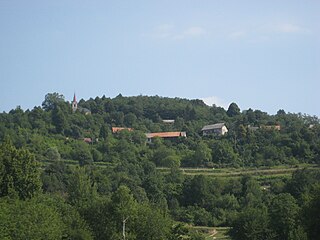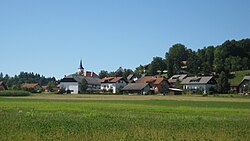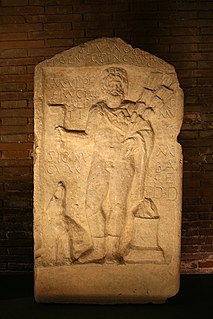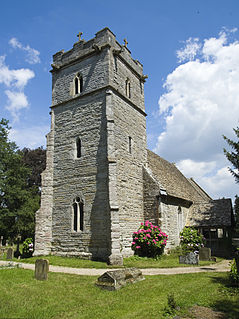
Komenda is a village in the Upper Carniola region of Slovenia. It is the seat of the Municipality of Komenda. It includes the formerly independent settlement of Kaplja Vas.

Metlika is a town and municipality in the southeastern Slovenia. It lies on the left bank of the Kolpa River on the border with Croatia. The municipality is at the heart of the area of White Carniola, the southeastern part of the traditional region of Lower Carniola. It is now included in the Southeast Slovenia Statistical Region.

Britof is a settlement just northeast of the town of Kranj in the Upper Carniola region of Slovenia.

Setnica is a settlement that is divided between the municipalities of Dobrova–Polhov Gradec and Medvode in the Upper Carniola region of Slovenia. Setnica is known as Snica in the local dialect. In the 19th century it was known as Setnitza in German. The settlement includes the hamlets of Ravnek to the south, Mežnar below Saint Ursula's Church, and Kobilca in the Maček Gorge.

Bojanja Vas is a village in the Municipality of Metlika in the White Carniola area of southeastern Slovenia, next to the border with Croatia. The entire area is part of the traditional region of Lower Carniola and is now included in the Southeast Slovenia Statistical Region.

Boršt is a small settlement on the left bank of the Kolpa River in the Municipality of Metlika in the White Carniola area of southeastern Slovenia. The entire area is part of the traditional region of Lower Carniola and is now included in the Southeast Slovenia Statistical Region.

Gornji Suhor pri Metliki is a settlement in the Municipality of Metlika in the White Carniola area of southeastern Slovenia, right on the border with Croatia. The entire area is part of the traditional region of Lower Carniola and is now included in the Southeast Slovenia Statistical Region.

Krasinec is a settlement on the left bank of the Kolpa River in the Municipality of Metlika in the White Carniola area of southeastern Slovenia, right on the border with Croatia. The area is part of the traditional region of Lower Carniola and is now included in the Southeast Slovenia Statistical Region.

Krašnji Vrh is a small village in the Municipality of Metlika in the White Carniola area of southeastern Slovenia, right on the border with Croatia. The area is part of the traditional region of Lower Carniola and is now included in the Southeast Slovenia Statistical Region.

Adlešiči is a settlement on the left bank of the Kolpa River in the Municipality of Črnomelj in the White Carniola area of southeastern Slovenia. The area is part of the traditional region of Lower Carniola and is now included in the Southeast Slovenia Statistical Region. It also encompasses a hamlet to the east near the bank of the Kolpa River called Nabrežci, also known as Nabreško Selo.

Marindol is a settlement on the terrace above the left bank of the Kolpa River in the Municipality of Črnomelj in the White Carniola area of southeastern Slovenia. The area is part of the traditional region of Lower Carniola and is now included in the Southeast Slovenia Statistical Region.

Purga is a small settlement above the left bank of the Kolpa River north of Adlešiči in the Municipality of Črnomelj in the White Carniola area of southeastern Slovenia. The area is part of the traditional region of Lower Carniola and is now included in the Southeast Slovenia Statistical Region.

Zilje is a settlement above the left bank of the Kolpa River in the Municipality of Črnomelj in the White Carniola area of southeastern Slovenia. The area is part of the traditional region of Lower Carniola and is now included in the Southeast Slovenia Statistical Region.

Zapuže pri Ribnici is a village in the hills north of Ribnica in southern Slovenia. The area is part of the traditional region of Lower Carniola and is now included in the Southeast Slovenia Statistical Region.

Veliko Trebeljevo is a settlement in the hills east of the capital Ljubljana in central Slovenia. It belongs to the City Municipality of Ljubljana. It was part of the traditional region of Lower Carniola and is now included with the rest of the municipality in the Central Slovenia Statistical Region.

Polšnik is a settlement in the Municipality of Litija in central Slovenia. Traditionally the area was part of Lower Carniola and is now included with the rest of the municipality in the Central Sava Statistical Region. Together with the two parts of the main settlement it also includes the hamlets of Na Puši, Seruč, Koprivnik, Slop, Glinjek, Velika Njiva, and Sušje.

Kolovrat is a settlement in the Municipality of Zagorje ob Savi in central Slovenia. The area is part of the traditional region of Upper Carniola. It is now included with the rest of the municipality in the Central Sava Statistical Region. The settlement includes the hamlets of Kal, Plavišnik, Prevalje, Spodnje Vrtače, Senčna Vas, and Strma Njiva.

Dobovec is a settlement in the Municipality of Trbovlje in central Slovenia. It lies in the hills above the right bank of the Sava River. Traditionally the area was part of the Lower Carniola region. It is now included with the rest of the municipality in the Central Sava Statistical Region.

Veliko Mlačevo is a village in the Municipality of Grosuplje in central Slovenia. It lies just southeast of Grosuplje itself in the historical region of Lower Carniola. The municipality is now included in the Central Slovenia Statistical Region. The settlement includes the hamlet of Boštanj south of the main settlement.

Šmartno ob Savi is a formerly independent settlement in the northeast part of the capital Ljubljana in central Slovenia. It was part of the traditional region of Upper Carniola and is now included with the rest of the municipality in the Central Slovenia Statistical Region.



























